Occupational environment monitoring of a paper manufacturing factory
99,000 ₫
Note: The above price is calculated for one sample, and the price may fluctuate depending on the area of the environment to be monitored and market movements. For more accurate pricing support, please refer to the price list or contact our consulting staff directly.
Monitoring the environment of a paper manufacturing factory is a session of collecting, analyzing, and evaluating factors at the workplace that may harm workers health.
Table of Contents
Toggle1. Overview of Paper Manufacturing Factories
a. What is a paper manufacturing factory?
Factory for paper manufacturing is a specialized facility used to manufacture paper from raw materials such as wood, pulp, recycled paper, synthetic fibers, etc. Paper produced in the factory can be used to make toilet paper, cardboard, printing paper, packaging paper, and many other applications. Paper manufacturing factories vary in size, from small factories producing tens of tons of paper per day to large factories producing thousands of tons per day.

b. Production stages in paper manufacturing factories
The main production stages in a paper manufacturing factory typically include:
- Raw material harvesting: Paper manufacturing materials include wood, grasses, straw, waste, recycled paper, and chemical components such as cellulose compounds, processing chemicals, bleaching agents, inks, adhesives, and colorants. Raw materials are selected and harvested to meet technical requirements for paper manufacturing.
- Material processing: Raw materials are processed to remove impurities, separate cellulose, and prepare for paper manufacturing.
- Cellulose extraction: Cellulose is extracted from raw materials and processed into pulp.
- Paper formation: Pulp is mixed with water and other chemicals to form a thick liquid called pulp slurry. The pulp is then poured into paper manufacturing machines, where it is pressed and processed into paper sheets.
- Paper finishing: After production, paper is processed and finished to achieve desired physical, chemical, and mechanical properties.
- Packaging and transportation: The final product is packaged and transported to sales points or end customers.

c. Machinery used in paper manufacturing factories
The machinery used in paper manufacturing factories depends on the scale and technology of the factory, but common machines include:
- Pulp grinder: Used to finely grind wood and other materials to produce pulp.
- Pulp press: Used to press pulp into paper sheets.
- Surface calendering machine: Used to smooth the paper surface and create gloss.
- Coating machine: Used to apply a protective coating on the paper surface.
- Paper cutter: Used to cut paper sheets into various sizes according to customer requirements.
- Quality control system: Used to inspect and adjust the quality of manufactured paper to ensure it meets necessary standards.
Other machinery such as water presses, gilding machines, paper scraping machines, printing machines, and film development machines may also be used during the paper manufacturing process.

d. Occupational diseases that may occur among workers in paper manufacturing factories
Workers in paper manufacturing factories may be exposed to many hazardous substances and are at risk of occupational diseases, such as:
- Respiratory diseases: Paper manufacturing employees are often exposed to dust from fibers and chemicals. Long-term exposure can cause pneumonia, asthma, allergic rhinitis, and other respiratory issues.
- Skin diseases: Exposure to chemicals, especially paper processing chemicals and inks, can cause irritation, dermatitis, rashes, bleeding, and other skin problems.
- Spine and joint disorders: Lifting and transporting paper can cause strain and injuries to the spine and joints.
- Depression and stress: Paper manufacturing work often requires high accuracy, concentration, and frequent work in noisy environments, which can lead to depression and stress.
- Light intensity-related conditions: Some production stages require strong lighting to inspect quality; prolonged exposure can harm workers’ eyesight.
- Hearing disorders: Some paper manufacturing equipment generates noise that can affect hearing.
- Heat-related conditions: High temperatures in large production rooms can cause heat stress, heat shock, sunburn, and other heat-related issues.

e. Common types of paper in the market
Currently, there are many common types of paper used for different purposes, including:
- Printing paper: Used for documents, images, publications, newspapers, books, and other applications.
- Cardboard: Thicker than printing paper, used for book covers, boxes, cartons, and other packaging products.
- Newsprint: Used for newspapers, magazines, and other printed materials.
- Toilet paper: Used for toilet paper, tissue, and other hygiene products.
- Consumer paper: Used for notes, drawing paper, price lists, reflective paper, and other applications.
- Industrial paper: Used for cardboard packaging, wrapping paper, rolls, and other industrial applications.
- Base paper: Thick and stiff paper used for bookbinding, CD covers, wedding cards, and other applications.

2. Overview of occupational environment monitoring services
a. What is occupational environment monitoring in paper manufacturing factories?
Occupational environment monitoring (or workplace environment measurement) in paper manufacturing factories involves collecting, evaluating, and analyzing measurements of workplace environmental factors in the factory. The goal is to implement timely measures to minimize environmental impacts on workers’ health and prevent occupational diseases. Occupational environment monitoring is a mandatory requirement for paper manufacturing factories.
It plays a critical role in protecting and improving workers’ health, as employees are the main resource and directly generate profit for the enterprise. Workers frequently exposed to risks and occupational hazards beyond permissible limits may suffer health effects and develop occupational diseases.
REGISTER FOR OCCUPATIONAL ENVIRONMENT MONITORING SERVICE
b. An Toan Nam Viet’s occupational environment monitoring program
An Toan Nam Viet’s program is developed by monitoring engineers specializing in occupational safety and environmental protection. Aiming to ensure workers’ health and safety, it uses modern methods to monitor air, water, microclimate, physical, and dust factors in the workplace. This program is essential for maintaining a safe work environment and protecting employees’ health.
Additionally, the program plays an important role in researching and developing new solutions to improve workplace environmental quality. With the dedication and professionalism of monitoring experts, An Toan Nam Viet’s exclusive program is a breakthrough in occupational safety and environmental management in Vietnam.

c. Standardization in occupational environment measurement procedures
Standardization in An Toan Nam Viet’s procedures is critical for ensuring measurement quality. To guarantee accuracy and reliability, the program follows standards recognized by the Ho Chi Minh City Department of Health. This ensures that collected data are reliable for evaluating work environments and making decisions to improve them for worker health protection.
Standardized procedures also ensure that measurements are conducted by highly qualified monitoring specialists with years of experience, enabling managers and experts to trust results from An Toan Nam Viet and make accurate, valuable decisions for worker health and environmental protection.
Applying standardization demonstrates An Toan Nam Viet’s commitment to ensuring a safe working environment and protecting employees’ health, while contributing to the development and improvement of occupational safety and environmental management in Vietnam.
d. Paper manufacturing factory monitoring reports
Occupational environment monitoring results are prepared according to Form No. 04, Appendix III of Decree 44/2016/ND-CP and created in two copies: one sent to the enterprise that contracted the monitoring service, and one retained by the monitoring organization.
Retention time of monitoring results is indefinite, as required by law.

e. Frequency of occupational environment monitoring as required by law
According to Clause 2 of Article 18 of Law on Occupational Safety and Hygiene 84/2015/QH13, employers must organize occupational environment monitoring to assess harmful factors at least once a year.
f. Deadline for submitting occupational environment monitoring reports as required by law
The submission deadline is before December 31 each year. Enterprises operating in manufacturing factories are required to submit occupational environment monitoring reports to the Department of Health at the locality where the enterprise’s headquarters is located and where employees work.
When there are changes in technology, manufacturing processes, or when renovating or upgrading workplaces that may introduce new harmful factors affecting workers’ health, enterprises must update occupational hygiene records regarding factors that require monitoring.
g. Regulations on penalties for violations of occupational environment monitoring by employers
According to Article 27 of Decree No. 12/2022/ND-CP dated January 17, 2022, regulating administrative penalties in labor, social insurance, and Vietnamese workers working abroad under contracts:
- Clause 2: A fine of VND 2,000,000 – 5,000,000 for employers who fail to publicly disclose to employees at the monitored workplace and the site being inspected, evaluated, and managed regarding hazardous factors immediately after receiving the monitoring results.
- Clause 3: A fine of VND 20,000,000 – 40,000,000 for employers who fail to conduct occupational environment monitoring to control hazards affecting workers’ health as prescribed by law.
- Clause 4: A fine of VND 40,000,000 – 60,000,000 for employers who collude with monitoring organizations to commit fraud in occupational environment monitoring activities but without criminal liability.
3. Harmful Environmental Factors for Workers in Paper Manufacturing Factories
Harmful environmental factors for workers in paper manufacturing factories may include:
- Dust: During paper production, processes such as processing, cutting, and packaging can generate paper dust. These fine dust particles can irritate the eyes, respiratory system, and skin.
- Chemicals: Paper production uses many chemicals, such as bleach, organic compounds, catalysts, solvents, additives, anti-moisture agents, and anti-mold agents. Exposure to these chemicals may cause health issues such as skin irritation, allergic reactions, and respiratory problems.
- Temperature and humidity: Paper production requires controlled temperature and humidity to ensure product quality. However, fluctuations in temperature and humidity in the factory may cause health issues for workers, such as rhinitis, headaches, and respiratory problems.
- Noise: Paper production often involves large machinery and specialized equipment, which can produce high levels of noise. Exposure to noise may lead to hearing problems and stress, affecting workers’ health.
- Lighting: Paper production often uses bright lighting to inspect product quality. However, intense light can cause eye strain and negatively affect workers’ vision.
- Air: Paper production typically uses equipment to filter and release dust and chemicals generated during production.
REGISTER FOR OCCUPATIONAL ENVIRONMENT MONITORING SERVICE
4. Measures to Improve Working Environment in Paper Manufacturing Factories
Measures to improve the working environment in paper manufacturing factories may include:
- Ensure proper ventilation and air circulation in the factory to minimize the accumulation of harmful gases and dust in the air.
- Use personal protective equipment such as masks, gloves, and safety glasses to protect workers from harmful agents and dust.
- Maintain regular industrial hygiene to reduce the accumulation of dust and waste in the working environment.
- Establish an environmental and occupational safety management system to ensure compliance with safety regulations, protect the environment, and minimize risks for workers.
- Adopt advanced production technologies to reduce the infiltration of harmful substances into the working environment.
- Train and educate workers about occupational safety and environmental protection to enhance the prevention of workplace accidents and occupational diseases.
- Regularly conduct occupational environment monitoring in the factory, collect and analyze harmful factors, and adjust to reduce risks to prevent occupational diseases for workers.
5. Benefits of Periodic Monitoring in Paper Manufacturing Factories
An Toan Nam Viet provides excellent benefits for enterprises using occupational environment monitoring services according to Decree 44/2016/ND – CP on managing and controlling harmful factors in the working environment affecting workers.
- Enterprises can proactively control harmful factors in the factory.
- Receive consultation and recommendations for measures to reduce harmful factors and improve workplace quality.
- Indirectly protect human resources, the main factor in business development.
- Reduce the impact of occupational diseases on health, thereby reducing future treatment costs.
- Improve workers’ health, leading to consistent product quality and output.
- Ensure compliance with occupational safety laws, avoiding legal risks.
- Create credibility and professionalism in all aspects, enhancing the enterprise’s brand value.
Nam Viet’s environmental monitoring service is a solution to reduce occupational disease risks, contributing to a clean and high-quality working environment.

6. Nationwide Occupational Environment Monitoring Center
Occupational Environment Monitoring Center of Nam Viet is a professional unit monitoring and measuring occupational environment quality across all provinces in Vietnam. With an experienced team of monitoring specialists, the center uses modern measuring devices to ensure accuracy and reliability.
In addition to monitoring services, the center supports clients in planning, handling, and following up on occupational environment issues. Following the principle “customer-centered,” the center prioritizes customer satisfaction, meets all client needs, and commits to providing the best solutions for businesses.
REGISTER FOR OCCUPATIONAL ENVIRONMENT MONITORING SERVICE
With investment in technology, equipment, and personnel, Nam Viet’s monitoring center has become a reputable unit in occupational environment monitoring in Ho Chi Minh City with the following goals:
- We always value brand reputation and service quality.
- We provide clients with the best and most suitable solutions.
- Along with a team of experienced Masters and Engineers dedicated to environmental protection and benefiting enterprises.
- By choosing Nam Viet Environmental Monitoring, your company will receive professional service from monitoring experts and the best cost incentives.
The occupational environment monitoring process at Nam Viet includes the following steps:
- Before monitoring, we ensure all machinery and equipment are calibrated and compliant with legal regulations.
- Conduct the full monitoring procedures as committed to the Department of Health.
- Report monitoring results honestly to the employer.
- If results indicate unsafe conditions, Nam Viet will assist with solutions, and the factory will implement:
- Measures to improve working conditions, minimize harmful factor impacts, and prevent occupational diseases.
- Health checks for early detection of occupational and work-related diseases for workers in unsafe areas.
- Material compensation for workers according to labor law regulations.

7. Occupational Environment Monitoring Price List
To help enterprises conduct occupational environment monitoring professionally and effectively, Nam Viet provides clients with a price list for occupational environment monitoring services that is both high-quality and reasonably priced.
- Our price list provides detailed information on the cost of monitoring services, including expenses for transportation, measurement, analysis, and reporting. Clients can fully trust the accuracy and reliability of our reports.
- We commit to offering competitive and reasonable prices and are always ready to consult and answer all questions about monitoring services quickly and professionally.
- With Nam Viet’s price list, clients can easily choose the service packages that fit their needs. We guarantee maximum satisfaction with professional service quality.
No comments yet

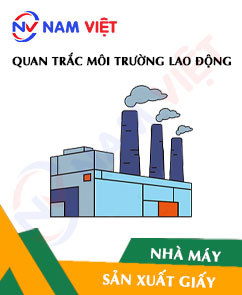
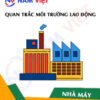
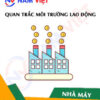


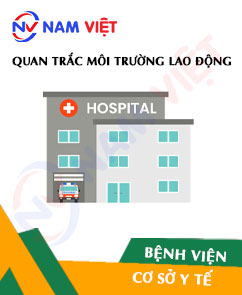
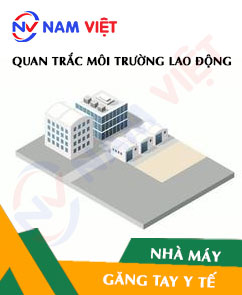



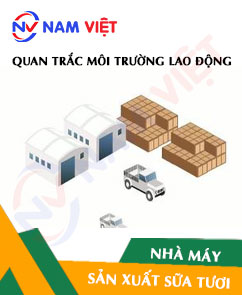
Review Occupational environment monitoring of a paper manufacturing factory
There are no reviews yet.